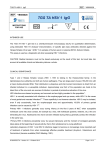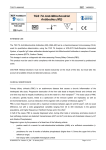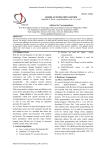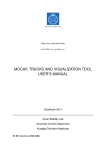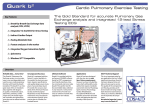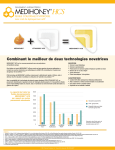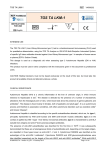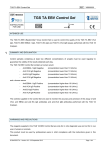Download TGS TA HSV 1/2 IgM
Transcript
TGS TA HSV 1/2 IgM REF REF YB500029 YB500029 TGS TA HSV 1/2 IgM INSTRUCTIONS FOR USE 100 INTENDED USE The TGS TA HSV 1/2 IgM test is a chemiluminescent immunoassay (CLIA) for quantitative determination, using TGS TA Analyser or IDS-iSYS Multi-Discipline Automated System instrumentation, of specific IgM class antibodies directed against the Herpes Simplex Virus type 1 and 2 (HSV 1/2) in samples of human serum or plasma (EDTA, Sodium Citrate). This assay is used as a diagnostic aid when assessing HSV type 1 and 2 infections. This product must be used in strict compliance with the instructions given in this document by professional users. CAUTION: Medical decisions must not be based exclusively on the result of this test, but must take into account all available clinical and laboratory data as a whole. CLINICAL SIGNIFICANCE Type 1 and 2 Herpes Simplex viruses (HSV 1, HSV 2) belong to the Herpesviridae family, in the Alphaherpesvirus subfamily and both are human pathogens. They are large-sized viruses (150-200 nm) with a linear double-stranded DNA. Their distribution is ubiquitous and inter-human transmission is direct from an infected individual to a susceptible individual. Approximately one third of the population are hosts to the latent form of the virus and are sources of infection in periods of productive activation of the virus. 1 HSV infections are classed as primary and recurrent and are highly prevalent in the population . HSV 1 is normally associated with infections in the oropharyngeal and eye areas, while HSV 2 is the cause 2,3 of most genital and neonatal infections . Tissue specificity is not however absolute. HSV 2 may be isolated, even if only occasionally, from the oropharyngeal area and approximately 10-20% of primary genital 4,5 infections can be caused by HSV 1 . 6 Primary HSV 1 infections generally occur during infancy (in the first 5 years of life) , when susceptible individuals come into close contact, for example by a kiss, with individuals (parents, relatives, etc.) who are eliminating the virus. Adolescents who have not been infected during infancy generally contract the infection in the same way. Primary HSV 2 infections prevalently occur by sexual intercourse and the moment of contagion generally takes place at the beginning of sexual activity, that is from adolescence to young adulthood. IFU039TGS TA – Version: 03 – 21 November 2014 Page 1 di 13 TGS TA HSV 1/2 IgM REF YB500029 Laboratory diagnosis of HSV 1 and HSV 2 infections began to become an increasingly more important part of treatment of patients from when increasingly effective possible treatment (Acyclovir, Valaciclovar and Farmiciclovir) became available (WHO Meeting, 1991). Diagnostic techniques include isolation of the virus by PCR, which permits both genomic quantity detection and genotype classification, and the IFA test, as well as serological assay which can prove useful for diagnosing primary HSV infections and for determining evidence of previous infections. Diagnosis of primary infections is based on detection of specific IgM class antibodies as well as to demonstrate seroconversion or 7 a significant increase in the concentration between acute and convalescent sera . Serological assay proves less useful for diagnosis of recurring HSV infections, since such infections often are not reflected in modified 7 levels of antibodies . Many serological tests offered on the market use purified viral lysates. Given that the cross-reaction between the two HSV serotypes is highly significant, use of these viral lysates does not permit correct differentiation 8 between HSV 1 and HSV 2 . Since most adult individuals have been infected with HSV 1, often, if clinical symptoms are absent, the anti-HSV 2 immune status is difficult to assess. The use of recombinant membrane glycoproteins specific for the type of virus makes it possible to distinguish exactly the patient’s immune status. The specific recombinant glycoproteins are gG1 for the type 1 virus and gG2 for the type 2 virus. They are used both to monitor the primary infection, by detecting the specific IgM 9 antibodies, and the patient’s immune status, by detecting the specific IgG antibodies . PRINCIPLE OF THE METHOD The TGS TA HSV 1/2 IgM kit for quantitative determination of specific anti-Herpes Virus type 1 and 2 IgM employs an indirect two-step immunological method based on the principle of chemiluminescence. Two specific antigens are used to coat the magnetic particles (solid phase) and an anti-human IgM antibody is labelled with an acridinium ester derivative (conjugate). The samples are pre-treated with an anti-IgG antibody to eliminate human immunoglobulins G (IgG) and Rheumatoid Factor (RF). During initial incubation, the specific antibodies present in the sample, in the calibrators or in the controls bond with the solid phase. During the second incubation, the conjugate reacts with the anti-HSV 1/2 IgM antibodies captured by the solid phase. After each incubation, the material that has not bonded with the solid phase is removed by aspiration and subsequent washing. The quantity of labelled conjugate that remains bonded to the solid phase is assessed by activation of the chemiluminescence reaction and measurement of the light signal. The generated signal, expressed in relative light units (RLU), is indicative of the concentration of specific antibodies present in the sample, in the calibrators and in the controls. IFU039TGS TA – Version: 03 – 21 November 2014 Page 2 di 13 TGS TA HSV 1/2 IgM REF YB500029 AUTOMATION The TGS TA Analyser instrument automatically performs all the operations envisaged by the assay protocol: addition of samples, calibrators, controls, magnetic particles, conjugates and chemiluminescence activation solutions to the reaction cuvette; magnetic separation and washing of particles; measurement of the emitted light. The system calculates the assay results for the samples and controls by means of a stored calibration curve and prints a report that includes all the information related to the assay and to the patient. MATERIALI E REAGENTI Materiali e reagenti forniti REAG 1 MP 2.5 mL Magnetic particles coated with recombinant gG1 (HSV 1) and gG2 (HSV 2) antigens in Phosphate Buffer containing stabilising proteins, surfactant, Pro-Clin 300 and sodium azide (< 0.1%) as preservatives. REAG 2 CONJ 25 mL Mouse Monoclonal anti-human IgM antibody labeled with an acridinium ester derivative (conjugate), in Phosphate Buffer containing stabilising proteins, surfactant, Pro-Clin 300 and sodium azide (< 0.1%) as preservative. REAG 3 DIL 25 mL Sample Diluent Solution: Phosphate Buffer containing bovine serum albumin, a surfactant, an inert blue colouring agent, Pro-Clin 300 and Gentamicin SO4 as preservatives. REAG 4 SORB 18 mL Serum (sheep) specific for eliminating the immunoglobulins G (IgG) and the Rheumatoid Factor (RF) from the samples in Glycine Buffer and sodium azide (< 0.1%) as the preservative. REAG 5 CAL A 1.6 mL Human serum with low concentration of anti-HSV 1 and 2 IgM antibodies in Phosphate Buffer containing bovine serum albumin, a surfactant, an inert blue colouring agent, Pro-Clin 300 and Gentamicin SO4 as preservatives. IFU039TGS TA – Version: 03 – 21 November 2014 Page 3 di 13 TGS TA HSV 1/2 IgM REAG 6 REF CAL B YB500029 1.6 mL Human serum with high concentration of anti-HSV 1 and 2 IgM antibodies in Phosphate Buffer containing bovine serum albumin, a surfactant, an inert blue colouring agent, Pro-Clin 300 and Gentamicin SO4 as preservatives. All reagents are ready for use. Reagents 1, 2, 3 and 4 are assembled in a single reagents cartridge unit. The Calibrator concentrations are expressed in UA/mL (arbitrary units) and calibrated against an internal reference standard. The concentration settings, specific for each production lot, are recorded on the DATA DISK included in the kit. DATA DISK A Mini-DVD containing data regarding all the products in the TGS TA line (Reagents, Calibrators, Control Sera) updated to the last production lot with the exclusion of products that have expired at the date when the new DATA DISK was compiled. Only the DATA DISK with the highest lot number needs to be kept to maintain the information required for correct operation of the system up to date. Materials and reagents required but not supplied in the kit: - TGS TA Analyzer 120 - TGS TA Cuvette Cube (1) Cod. No. TGS00001 (1) Code No. IS-CC1000 (2) Code No. IS-CS1000 Pack of 960 cuvettes - TGS TA System Liquid 1 bottle containing 5 liters of ready-to-use solution. - TGS TA Wash Solution (2) Code No. IS-CW1000 1 bottle containing 10 liters of ready-to-use solution. - TGS TA Trigger Set (2) Code No. IS-CT1000 1 250 mL-bottle of Trigger A (pre-trigger solution) 1 250 mL-bottle of Trigger B (trigger solution) - TGS TA D-SORB Solution Code No. YC500009 Pack of 2 bottles containing 1 liter of ready-to-use solution. - TGS TA Cartridge Checking System * Code No. IS-601000 - TGS TA ImmunoCleaner Code No. YC500012 IFU039TGS TA – Version: 03 – 21 November 2014 Page 4 di 13 TGS TA HSV 1/2 IgM REF YB500029 6 bottles each containing 27 mL - TGS TA Top Cap Set Code No. YC500010 300 red top caps to close the calibrator containers after first use. (1) Manufactured by IDS France SAS, 42 rue Stéphane Mazeau, 21320 Pouilly en Auxois, France and distributed by Technogenetics Srl. (2) Manufactured by Immunodiagnostic Systems S.A., Rue E. Solvay, 101, B-4000 Liège, Belgium and distributed by Technogenetics Srl. Other Recommended Reagents TGS TA HSV 1/2 IgM CONTROL SET Cod. No. YB500046 Three 1.5 mL vials of negative human serum and three 1.5 mL vials of human serum positive for anti-HSV 1/2 IgM antibodies. WARNINGS AND PRECAUTIONS The reagents supplied in the TGS TA HSV 1/2 IgM kit are only for in vitro diagnostic use and not for in vivo use in humans or animals. This product must be used in strict compliance with the instructions given in this document by professional users. Technogenetics cannot be held responsible for any losses or damages caused by use not in conformity with the instructions supplied. Safety precautions This product contains material of animal origin and therefore must be handled as if it contains infecting agents. This product contains components of human origin. All units of serum or plasma used to produce the reagents in this kit have been analysed with FDA-approved methods and found not to be reactive due to presence of HBsAg, anti-HCV, anti-HIV1 and anti-HIV2. However, since no analysis method is able to guarantee the absence of pathogenic agents, all material of human origin must be considered to be potentially infected and handled as such. In the event of damaged packaging or accidental leakage, decontaminate the area concerned with a diluted solution of sodium hypochlorite after putting on suitable personal protective equipment (overall, gloves, goggles). Dispose of the material use for the clean-up and of the packaging involved in the leakage according to national regulations for disposal of potentially infected waste. In the event of damaged packaging or accidental leakage, do not use the reagents to perform the assay. Some reagents contain sodium azide as a preservative. Since sodium azide may react with lead, copper and leaded brass forming explosive azides in piping, it is recommended that reagents or waste are not poured IFU039TGS TA – Version: 03 – 21 November 2014 Page 5 di 13 TGS TA HSV 1/2 IgM REF YB500029 down drains but are disposed of in compliance with the national regulations on disposal of potentially hazardous waste. Operating precautions Reliable results can only be obtained by strictly complying with these instructions and carefully following what is written in the operating manual for the instrument. The reagents supplied in the kit must be used only with the TGS TA Analyzer system. The components of the reagent cartridge must not be removed from the cartridge and reassembled. Do not use the kit after its expiry date. REAGENT PREPARATION The reagents supplied in the kit are all ready for use. REAGENT STORAGE AND STABILITY Store the reagents supplied in the kit at 2-8°C in a vertical position in a dark place. In these conditions, unopened reagent cartridge and calibrators are stable until the expiry date. After opening, the reagent cartridge can be used for 60 days if kept in a refrigerator at 2-8°C or in the analyser. After opening, the calibrators can be used for 60 days if kept in a refrigerator at 2-8°C and if they have not been left in the analyser for more than 6 hours per session. Do not freeze the reagents and calibrators. SAMPLE PREPARATION AND STORAGE The assay must be performed on samples of human serum and plasma (EDTA – Sodium Citrate). Use of lipaemic, haemolysed and turbid samples is not recommended. If the assay is performed after more than 8 hours, separate the serum or the plasma from the clot, from the red blood cells and transfer the supernatant from the gel separating tubes to the secondary tubes. Before being analysed, samples may be kept in a refrigerator at 2-8°C for a maximum of 7 days. If the assay is to be performed after more than 7 days, store the samples frozen (< -20°C). Avoid repeated freezing and thawing. OPERATING PROCEDURE Carefully follow the instructions given in the user manual of the instrument to obtain reliable analytical results. Loading of reagents All the reagents supplied in the kit are ready for use. IFU039TGS TA – Version: 03 – 21 November 2014 Page 6 di 13 TGS TA HSV 1/2 IgM REF YB500029 Before inserting the reagent cartridge in the system, the magnetic particle container must be horizontally agitated by rotation in order to ensure correct resuspension of the particles. Avoid generating foam when performing this operation. Place the reagent cartridge in the reagent area of the instrument using the rack provided and leave it to be agitated for at least 40 minutes before use. Positioning of the reagent cartridge simultaneously determines reading of the identification bar-code. If the cartridge label is damaged or if it is not readable, the reagent cartridge identification data can be entered manually. The instrument automatically maintains the magnetic particles constantly agitated. If the reagent cartridge is removed from the instrument, store it at 2-8°C in a vertical position in a dark place. Loading of calibrators TGS TA calibrators are ready for use. Leave the calibrators at room temperature for 10 minutes and then gently shake the contents, either manually or using a vortex, avoiding the formation of foam. When using the calibrators for the first time, remove the guarantee seal and the white sealing cap before placing them in the analyser. If the calibrators have already been used, the container will have a top cap (red cap) with no guarantee seal. Remove the red closing cap before placing them in the analyser. Place the calibrators in the samples area of the analyser; see the analyser user manual on how to identify them in the analyser. Bar-code data must be entered manually if the label is damaged or if it is unreadable. The readings for the IgM anti-HSV 1/2 antibody concentration in the calibrators are recorded in the DATA DISK and automatically transferred to the analyser. At the end of the session, the calibrator containers must be closed with the top caps (red caps) provided and stored at 2-8°C until they are used again. The calibrators can be used for a maximum of four times. Loading of controls Place the controls in the samples area of the analyser. See the analyser user manual on how to identify them in the analyser. If there is no bar-code on the control or if it is not readable, the control identification data must be entered manually. If TGS TA Controls are used, see the instructions for use provided. The readings for the IgM anti-HSV 1/2 antibody concentration in the TGS TA controls are recorded in the DATA DISK and automatically transferred to the analyser. Select the required parameters for each control. Loading of samples Place the samples in the samples area of the analyser; see the analyser user manual on how to identify them in the analyser. If there is no bar-code on the sample or if it is not readable, the sample identification data must be entered manually. Select the required parameters for each sample. IFU039TGS TA – Version: 03 – 21 November 2014 Page 7 di 13 TGS TA HSV 1/2 IgM REF YB500029 Calibration The TGS TA Analyzer instrument uses a memorised calibration curve (master curve), generated by the manufacturer for each lot of reagent cartridges. The “master curve” parameters, together with the calibrator concentration settings, are stored in the DATA DISK and transferred to the instrument’s database. Calibrators A and B are used to recalibrate the “master curve” in both for the instrument used and for the reagents on board. To recalibrate, analyse three replicates of the two calibrators (A and B) and one replicate of each control. The concentration obtained with the controls make it possible to validate the new calibration. Once recalibration of the “master curve” has been accepted and stored in memory, all subsequent samples can be analysed without any further calibration, except in the following cases: - when a reagent cartridge with a new lot number is loaded into the instrument; - when the controls do not fall within the range of acceptability; - after instrument maintenance; - when the validity of the recalibrated “master curve” has expired. The validity of the recalibrated “master curve” for the TGS TA HSV 1/2 IgM kit is 21 days. Recalibration management is handled automatically by the analyser. Assay Press the start button. 1. The system aspirates 100 µL of Sample Diluent, 20 µL of Magnetic Particles, 86 µL of Sample Diluent and 18 µL of sample or control pretreated in the analyser in a 1:14 dilution with the Sorbent reagent (for the calibrators the positive serum is supplied prediluted with Sample Diluent and the volume aspirated is 104 µL). The aspirated solutions and suspension are dispensed into the reaction cuvette. 2. The reaction cuvette is incubated in the rotor at 37°C for 20 minutes. 3. After this phase of incubation, the magnetic particles are separated and washed. 4. 200 µL of conjugate are dispensed into the cuvette. 5. The reaction cuvette is incubated in the rotor at 37°C for 10 minutes. 6. After this last phase of incubation, the magnetic particles are separated and washed and the cuvette is transferred to the reading chamber. 7. The quantity of conjugate bonded to the solid phase, expressed in RLU, is directly proportional the concentration of anti-HSV 1/2 IgM present in the sample. 8. The readings obtained are interpolated on the calibration curve and transformed into concentrations. Samples with concentration higher than the upper limit of the measurable range can be diluted and retested. The new value obtained is multiplied, to obtain the final result, by the dilution factor used. QUALITY CONTROL To ensure the validity of the assay, control sera at differing levels of concentration (at least one negative serum and one positive serum) must be measured every day in which dosage is performed. IFU039TGS TA – Version: 03 – 21 November 2014 Page 8 di 13 TGS TA HSV 1/2 IgM REF YB500029 If individual laboratory practice so dictates, more frequent or more numerous controls may be performed for verification of assay results. Follow local quality control procedures. If TGS TA control sera are used, the expected average concentration and the acceptability limits are those given on the DATA DISK included in the control set pack too. If different control sera are used, before using them, the values expected with TGS TA reagents and system must be defined. If the control values does not fall within the specified range of acceptability, the related assay results are not valid and the respective samples must be analysed again. In this case, before repeating the tests, a recalibration procedure must be performed. CALCULATION AND INTERPRETATION OF THE RESULTS Calculation of the results The concentration of the anti-HSV 1/2 IgM present in the samples that are being tested is automatically calculated by the system. The results can be viewed on the display or printed. The concentrations are expressed in UA/mL. Calculation of the analyte concentration in the sample takes place by interpolating the response obtained for each sample on a calibration curve calculated in accordance with a 4-parameter logistic fitting (4PL, Y weighted), periodically corrected according to the responses obtained for calibrators assay results. For detailed information on how the system calculates the results, please see the analyser user manual. Interpretation of the results The measurement range of TGS TA HSV 1/2 IgM is: 0.0 – 120 UA/mL. Values lower than 0.0 UA/mL are extrapolated values, the message “OMR-” and/or ORA appears and they are shown as “equal to 0.0 UA/mL”. Values higher than 120 UA/mL are accompanied by the message “OMR+” and/or ORA and may retested after suitable dilution. The results of the samples may be interpreted in the following way: UA/mL) Interpretation < 20 The sample must be considered to be Negative for anti-HSV 1 and HSV 2 IgM ≥ 20 The sample must be considered to be Positive for anti-HSV 1 and HSV 2 IgM The values reported above are indicative only. Each laboratory will establish its own reference intervals. IFU039TGS TA – Version: 03 – 21 November 2014 Page 9 di 13 TGS TA HSV 1/2 IgM REF YB500029 LIMITS TO THE ASSAY METHOD For diagnostic purposes, the results obtained with the TGS TA HSV 1/2 IgM kit and the TGS TA Analyser system must be used together with the other clinical and laboratory data available to the physician. Bacterial contamination of the sample and heat inactivation may influence the result of the dosage. Heterophilic antibodies present in human serum samples may react with immunoglobulin-based reagents, causing interference with in vitro immunological dosages. Such samples may give rise to anomalous readings if analysed with the TGS TA HSV 1/2 IgM kit. EXPECTED VALUES 129 selected non immune samples have been analysed to check absence of anti-HSV 1/2 IgM antibodies. All samples analysed proved negative, with a mean value of 1.50 UA/mL and a standard deviation of 1.84 UA/mL. Using the results obtained, the “Limit of Blank” (LoB = the highest reading value that can be expected in a series of samples that do not contain the analyte) was calculated. The “Limit of Blank”, determined as 95° percentile of the negative population, is equal to 5.1 UA/mL with Reagent lot. n. 1. PERFORMANCES Caution: the data presented do not represent the operating specifications of the kit, but serve as experimental proof of how the kit works within these specifications in the manner envisaged by the manufacturer. Precision and Reproducibility The precision and the reproducibility of the TGS TA HSV 1/2 IgM kit have been assessed using a protocol based on the guidelines given in Clinical and Laboratory Standards (CLSI) document EP5-A2. The precision was calculated by analysing the results of 20 replicates of four sera (one negative and three positive with differing concentrations of anti-HSV 1/2 IgM) performed with two different lots of reagents in the same test run. The concentration of the negative anti-HSV 1/2 IgM (HSM-NC-01) serum gave results from 0.5 to 2.4 UA/mL and 0 UA/mL with reagent lots nos. 1 and 2. The table shows the results obtained with the 3 positive sera. IFU039TGS TA – Version: 03 – 21 November 2014 Page 10 di 13 TGS TA HSV 1/2 IgM Sample 1 2 3 REF Reagents Lot no. 1 2 1 2 1 2 Average concentration (UA/mL) 23.8 26.2 22.7 24.6 31.2 30.7 YB500029 SD (UA/mL) CV % 2.25 2.00 1.57 1.32 1.75 1.96 9.5 7.6 6.9 5.4 5.6 6.4 The reproducibility was calculated by analysing the results of the determination of five sera (one negative and four positive with differing concentrations of anti-HSV 1/2 IgM) performed in single replicate, in 15 different sessions, with two lots of reagents. The concentration of the negative anti-HSV 1/2 IgM (HSM-N3) serum gave results in the range from 0.0 to 1.1 UA/mL. The table shows the results obtained with the 4 positive sera. Sample Average concentration (UA/mL) SD (UA/mL) CV % 1 26.8 1.87 7.0 2 24.2 1.50 6.2 3 33.4 1.67 5.0 4 36.8 2.26 6.1 Analytical Sensitivity The analytical sensitivity of the TGS TA HSV 1/2 IgM kit was assessed using a protocol based on the guidelines given in Clinical and Laboratory Standards (CLSI) document EP17-A. In one case referred to as the Limit of Detection (LoD: that is the smallest quantity of analyte that the method is able to measure) the formula for calculating LoD = LoB + Cβ SDs (in which LoB is the “Limit of Blank”, SDs is the estimated standard deviation of the distribution of the sample at low concentration and C β is derived from 95° percentile of the standard Gaussian distribution) was applied. Three low concentration samples of analyte were used, determined singly with one batch of reagents in 15 different tests. The Limit of Detection of the TGS TA HSV 1/2 kit proved to be 9.1 UA/mL. In the other protocol, calculation of the Minimum Detectable Concentration (MDC) is envisaged: 20 replicates of the solution of the 0 UA/mL Standard of the Master curve were used. The average and the standard deviation (SD) were formulation on a lot of the kit. The RLU value related to the average + 2.6 SD was interpolated on the curve and the related concentration was obtained from this value. The analytical sensitivity expressed as the Minimum Detectable Concentration is 4.9 UA/mL. IFU039TGS TA – Version: 03 – 21 November 2014 Page 11 di 13 TGS TA HSV 1/2 IgM REF YB500029 The minimum detection values, together with considerations of a clinical kind and the results of comparison with reference methods contributed to the definition of the cut-off value. Analytical Specificity: Interferences A study based on the guidelines given in the CLSI document EP7-A2 has shown that the dosage performances are not influenced by the presence in the sample of the potentially interfering substances listed in the table below, up to the tested concentration. Potentially Interfering Substances Maximum tested concentration Free bilirubin Conjugated bilirubin Haemoglobin Triglycerides 20 20 1000 3000 mg/dL mg/dL mg/dL mg/dL Use of lipaemic, haemolysed and turbid samples is not in any case recommended. Rheumatoid Factor (RF) It was demonstrated that on 5 samples, the presence of Rheumatoid Factor (at concentrations ranging between 796 and 1831 UI/mL) did not interfere with the assay. Analytical Specificity: Cross reactions In order to assess potential cross reactions of the antigen used to sensitise the microparticles, a study was conducted using 26 samples, all with IgM antibodies positive for Herpes antigens and TORC antigens and IgM antibodies negative for HSV 1/2. The samples used were subdivided as follows: 6 EBV VCA, 5 Rubella, 6 Toxoplasma, 4 CMV, 2 VZV, 3 Mumps. The study did not show any significant cross reaction between the solid phase antigen and the other antibodies. Relative Sensitivity and Specificity The presence of anti- HSV 1/2 IgM antibodies was determined using the TGS TA HSV 1/2 IgM kit and an ELISA assay available on the market in 246 samples. 4 samples gave rise to discordant results between the TGS TA assay and the other available method. The relative concordance was therefore found to be 98.4% (95% Confidence Interval: 95.6 – 99.5%) (242/246). The relative sensitivity was found to be 92.6% (95% Confidence Interval: 74.2 – 98.7%) (25/27). The relative specificity was found to be 99.1% (95% Confidence Interval: 96.4 – 99.8%) (217/219). IFU039TGS TA – Version: 03 – 21 November 2014 Page 12 di 13 TGS TA HSV 1/2 IgM REF YB500029 BIBLIOGRAPHY 1. Xu F, Sternberg MR, Kottiri BJ, et al. Trends in herpes simplex virus type 1 and type 2 seroprevalence in the United States. JAMA 2006; 296: 964-973. [PubMed:16926356] 2. Chayavichitslip P, Buckwalter JV, Krakowski AC, Friedlander SF. Herpes Simplex. Pediatr Rev. 2009; 30(4):119-29. 3. Centers for Disease Control and Prevention. Sexually transmitted diseases treatment guidelines 2002. MMWR 2002: 51 (No. RR-6) 4. Lamey Pj, Hyland PL. Changing epidemiology of herpes simplex type 1 infections. Herpes 199; 6:20-24. 5. Nieuwenhuis RF,van Doorum Gj, Mulder PG, et al. Importance of herpes simplex virus type 1 (HSV 1) in primary genital herpes. Acta Derm Venereol 2006;86: 129-134.[PubMed:16648915] 6. Lycke E and Jeansson S: Herpes Simplex Virus. in EH Lenette, P Halonen and FA Marphy, eds. Laboratory Diagnosis of Infectious Diseases: Principals and Practice, vol. II: Viral, Rickettsial and Clamydial diseases, Springer-Verlag, Berlin, pp211,1988. 7. Drew WL and Rawls WE. Herpes simplex viruses, in EH Lenette, A Ballows, WJ Hausler and HJ th Shadomy, eds, Manual of Clinical Microbiology, 4 ed., American Society for Microbiology, Washington, DC, pp 705, 1985. 8. Arvin A, C Prober. Herpes Simplex Virus. 876-883. In Murray P, E Baron, M Pfaller, F Tenover, and R th Yolken (eds). Manual of Clinical Microbiology. 6 Ed. ASM, Washington D.C. (1995). 9. Bergström T, Trybala E. Antigenic differences between HSV 1 and HSV 2 glycoproteins and their importance for type-specific serology. Intervirology. 1996; 39 (3): 176-84. TECHNOGENETICS S.r.l. Via Vanvitelli, 4 20129 – Milano – Italy IFU039TGS TA – Version: 03 – 21 November 2014 Page 13 di 13














